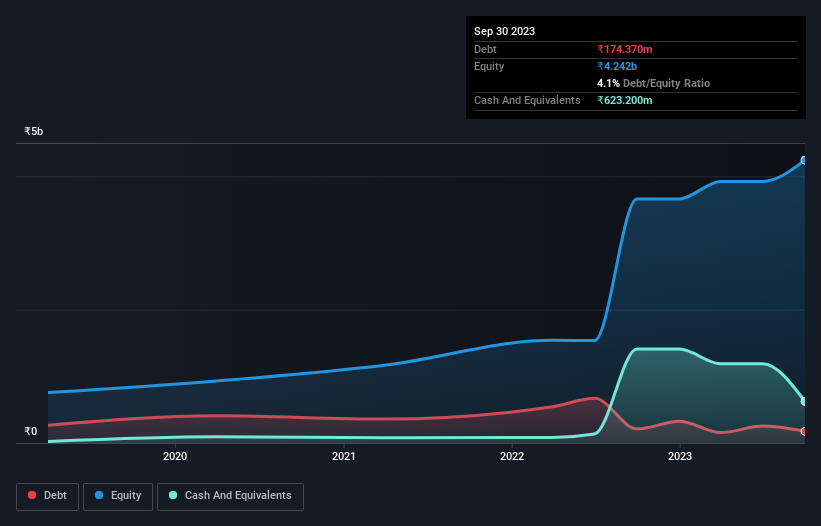- India
- /
- Professional Services
- /
- NSEI:EMUDHRA
These 4 Measures Indicate That eMudhra (NSE:EMUDHRA) Is Using Debt Reasonably Well

The external fund manager backed by Berkshire Hathaway's Charlie Munger, Li Lu, makes no bones about it when he says 'The biggest investment risk is not the volatility of prices, but whether you will suffer a permanent loss of capital.' It's only natural to consider a company's balance sheet when you examine how risky it is, since debt is often involved when a business collapses. Importantly, eMudhra Limited (NSE:EMUDHRA) does carry debt. But the more important question is: how much risk is that debt creating?
When Is Debt Dangerous?
Debt and other liabilities become risky for a business when it cannot easily fulfill those obligations, either with free cash flow or by raising capital at an attractive price. Ultimately, if the company can't fulfill its legal obligations to repay debt, shareholders could walk away with nothing. However, a more usual (but still expensive) situation is where a company must dilute shareholders at a cheap share price simply to get debt under control. Of course, the upside of debt is that it often represents cheap capital, especially when it replaces dilution in a company with the ability to reinvest at high rates of return. When we think about a company's use of debt, we first look at cash and debt together.
Check out our latest analysis for eMudhra
What Is eMudhra's Net Debt?
You can click the graphic below for the historical numbers, but it shows that eMudhra had ₹174.4m of debt in September 2023, down from ₹211.2m, one year before. However, it does have ₹623.2m in cash offsetting this, leading to net cash of ₹448.8m.

How Strong Is eMudhra's Balance Sheet?
We can see from the most recent balance sheet that eMudhra had liabilities of ₹744.0m falling due within a year, and liabilities of ₹121.1m due beyond that. Offsetting this, it had ₹623.2m in cash and ₹1.06b in receivables that were due within 12 months. So it can boast ₹815.9m more liquid assets than total liabilities.
This short term liquidity is a sign that eMudhra could probably pay off its debt with ease, as its balance sheet is far from stretched. Succinctly put, eMudhra boasts net cash, so it's fair to say it does not have a heavy debt load!
Also positive, eMudhra grew its EBIT by 22% in the last year, and that should make it easier to pay down debt, going forward. There's no doubt that we learn most about debt from the balance sheet. But it is eMudhra's earnings that will influence how the balance sheet holds up in the future. So if you're keen to discover more about its earnings, it might be worth checking out this graph of its long term earnings trend.
Finally, a business needs free cash flow to pay off debt; accounting profits just don't cut it. eMudhra may have net cash on the balance sheet, but it is still interesting to look at how well the business converts its earnings before interest and tax (EBIT) to free cash flow, because that will influence both its need for, and its capacity to manage debt. Over the last three years, eMudhra recorded negative free cash flow, in total. Debt is far more risky for companies with unreliable free cash flow, so shareholders should be hoping that the past expenditure will produce free cash flow in the future.
Summing Up
While it is always sensible to investigate a company's debt, in this case eMudhra has ₹448.8m in net cash and a decent-looking balance sheet. And we liked the look of last year's 22% year-on-year EBIT growth. So we don't have any problem with eMudhra's use of debt. When analysing debt levels, the balance sheet is the obvious place to start. However, not all investment risk resides within the balance sheet - far from it. To that end, you should be aware of the 1 warning sign we've spotted with eMudhra .
When all is said and done, sometimes its easier to focus on companies that don't even need debt. Readers can access a list of growth stocks with zero net debt 100% free, right now.
If you're looking to trade eMudhra, open an account with the lowest-cost platform trusted by professionals, Interactive Brokers.
With clients in over 200 countries and territories, and access to 160 markets, IBKR lets you trade stocks, options, futures, forex, bonds and funds from a single integrated account.
Enjoy no hidden fees, no account minimums, and FX conversion rates as low as 0.03%, far better than what most brokers offer.
Sponsored ContentNew: Manage All Your Stock Portfolios in One Place
We've created the ultimate portfolio companion for stock investors, and it's free.
• Connect an unlimited number of Portfolios and see your total in one currency
• Be alerted to new Warning Signs or Risks via email or mobile
• Track the Fair Value of your stocks
Have feedback on this article? Concerned about the content? Get in touch with us directly. Alternatively, email editorial-team (at) simplywallst.com.
This article by Simply Wall St is general in nature. We provide commentary based on historical data and analyst forecasts only using an unbiased methodology and our articles are not intended to be financial advice. It does not constitute a recommendation to buy or sell any stock, and does not take account of your objectives, or your financial situation. We aim to bring you long-term focused analysis driven by fundamental data. Note that our analysis may not factor in the latest price-sensitive company announcements or qualitative material. Simply Wall St has no position in any stocks mentioned.
About NSEI:EMUDHRA
eMudhra
Provides trust and enterprise solutions to individuals and organizations worldwide.
Flawless balance sheet with high growth potential.
Similar Companies
Market Insights
Community Narratives



